Nestled in the heart of the Wallis canton, St. Niklaus is a village that packs a punch in history—much more than a scenic stop between Zermatt and the Matterhorn. You’re not far off if you’re picturing quiet, snow-covered streets and quaint little houses. Should you travel to Zermatt, make sure you stop in St. Niklaus on the way. Behind the charming facades, St. Niklaus is a place where the past and present collide—sometimes with a little comic relief.
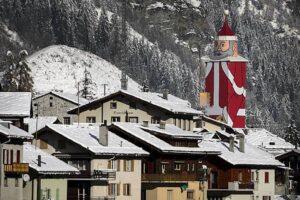
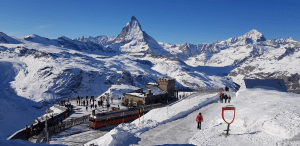
So, let’s take a stroll through time, shall we? Spoiler: There are avalanches, stubborn miners, and a whole lot of Swiss grit along the way.
The Early Days: From Glacier to Grazing
St. Niklaus has been around longer than your great-grandparents’ fondue pot—though it’s safe to say it’s seen more than a few cheese melts since its humble beginnings. The village dates back to the Middle Ages when early settlers made their living in what was probably a very “you do it, I’ll help” sort of way. They tamed the alpine wilderness, carved out paths in the snow, and prayed their cows wouldn’t wander off too far.
Back then, life was rough: no Wi-Fi, no Uber Eats—just snow, cold, and the occasional avalanche. Yet, the locals took it all in stride, with a practical sense of humor only the Swiss can truly pull off. You didn’t just survive in the Alps—you had to outsmart nature, your neighbors, and maybe even the cows.
The Golden Age of Miners and Merchants
Fast forward a few centuries, and St. Niklaus transformed into a key stop on trade routes. By the 19th century, the village had a strong mining community. Gold and silver flowed like fondue (okay, maybe not that much) and made St. Niklaus a buzzing little hub for traders, miners, and merchants.
Fun fact: Some of these merchants were not shy about their competitive edge. In fact, it was rumored that there were more rivalries in this little village than in a high school gym on sports day. Miners would boast of their discoveries, while the merchants would argue over the best prices, probably over a cup of schnapps—because nothing says “negotiations” like a good drink.
Nature’s Drama: Avalanches, Floods, and Resilience
If you’ve ever wondered what “Swiss determination” looks like, it’s probably the folks in St. Niklaus who kept rebuilding after nature gave them a run for their money. From avalanches to floods, the village has had its fair share of drama—yet, it always came out stronger.
There was no shortage of “well, that was fun” moments when St. Niklaus faced its periodic natural disasters. If the snow didn’t come crashing down, the river would rise, making the village’s survival more of a seasonal sport than a permanent residence. But no matter the challenge, the people of St. Niklaus rebuilt—and they did it with the dry wit and stubborn resolve you’d expect from people who’ve spent too many winters under the same pile of snow.
Modern St. Niklaus: A Blend of History and Charm
Fast forward to today, and St. Niklaus is still very much alive in history. The village is a lovely blend of old-world charm and modern-day conveniences, with a healthy respect for its heritage. Visitors can explore ancient buildings, walk the paths once trodden by miners, or marvel at the alpine views that haven’t changed in centuries—though these days, tourists might find their way to a cafe for some locally made cheese instead of trading minerals.
For those looking to soak in the best of both worlds, St. Niklaus is the perfect place. You can hike the surrounding mountains, visit local museums (maybe even catch a goat or two on their way to town), or simply enjoy the peace and quiet that comes with living in a place where history isn’t just in the books—it’s alive in the streets, the architecture, and even in the air.
Conclusion
Visiting St. Niklaus is like flipping through a Swiss history book—except with better views, fresher cheese, and fewer tedious footnotes. Whether you’re a history buff, a mountain enthusiast, or just someone in search of a picturesque Swiss village, St. Niklaus offers a little something for everyone. It’s not just a stop on your journey; it’s a place that invites you to pause, reflect, and maybe even laugh a little—because, after all, history was never meant to be too serious.
Your Blogging Friend Ulrich Koepf
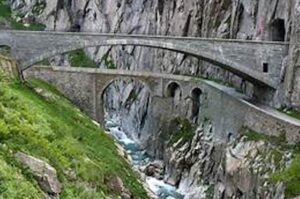 devils bridge[/caption]
devils bridge[/caption]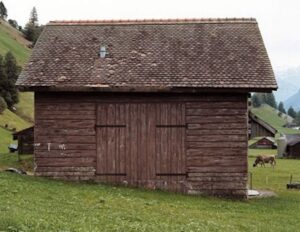
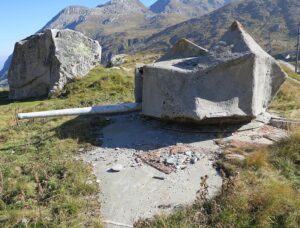 Canon Barn & Rock Camouflage[/caption]
Canon Barn & Rock Camouflage[/caption]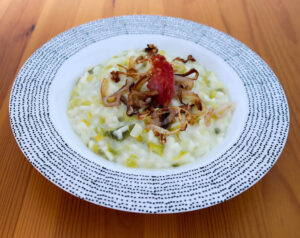 Riis & Poor[/caption]
Riis & Poor[/caption]